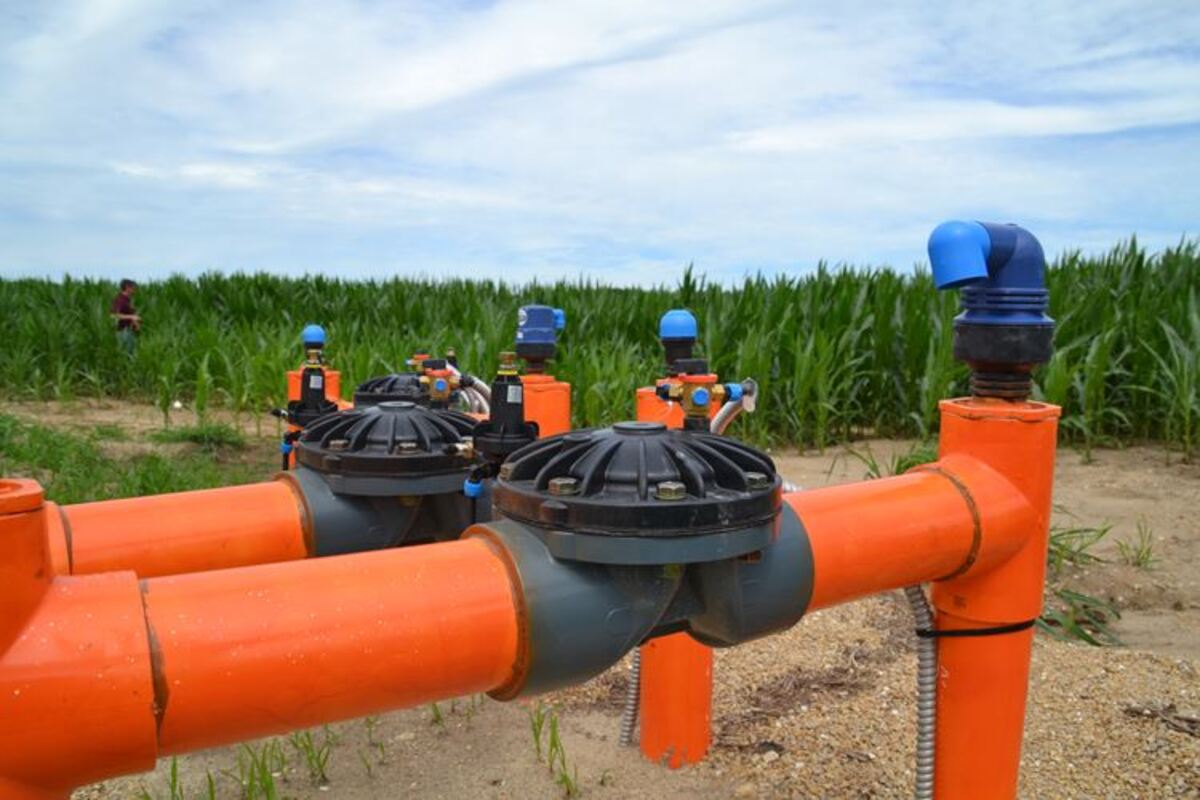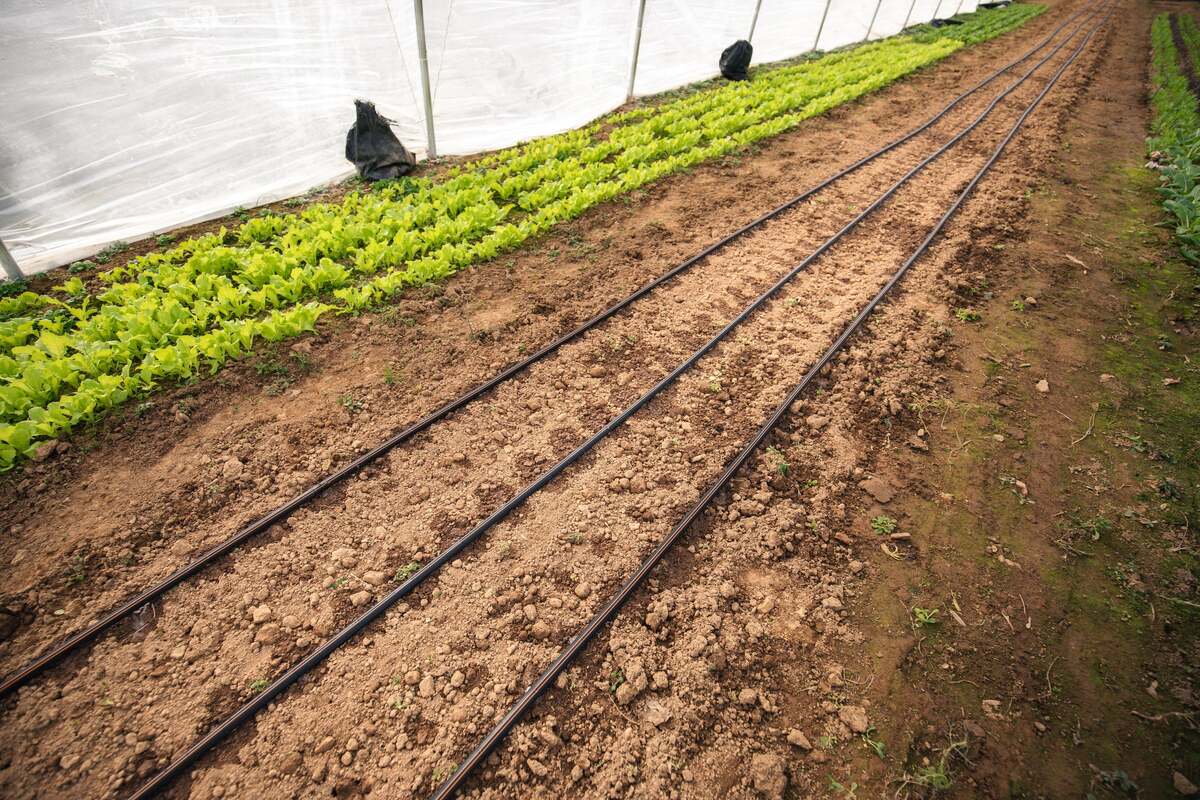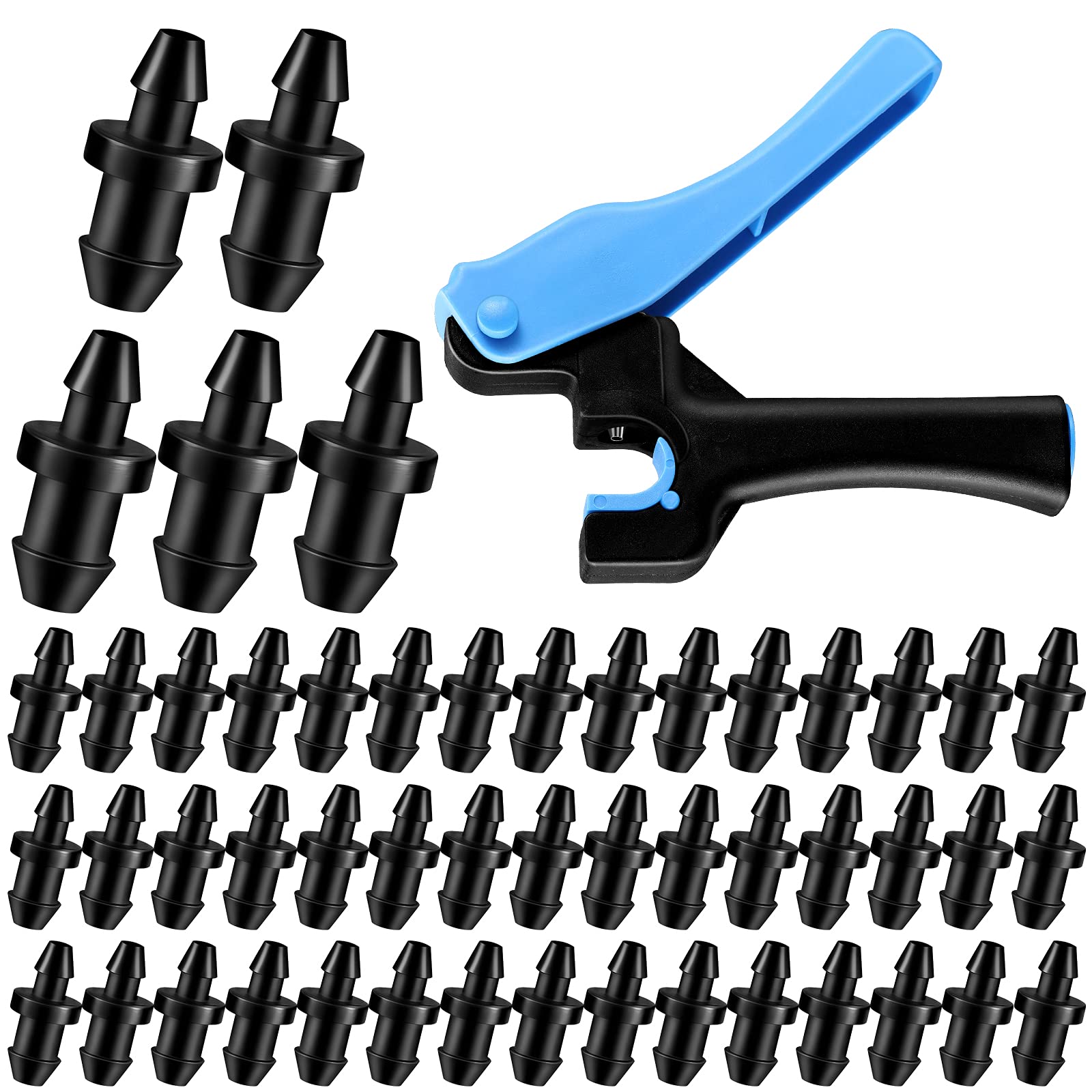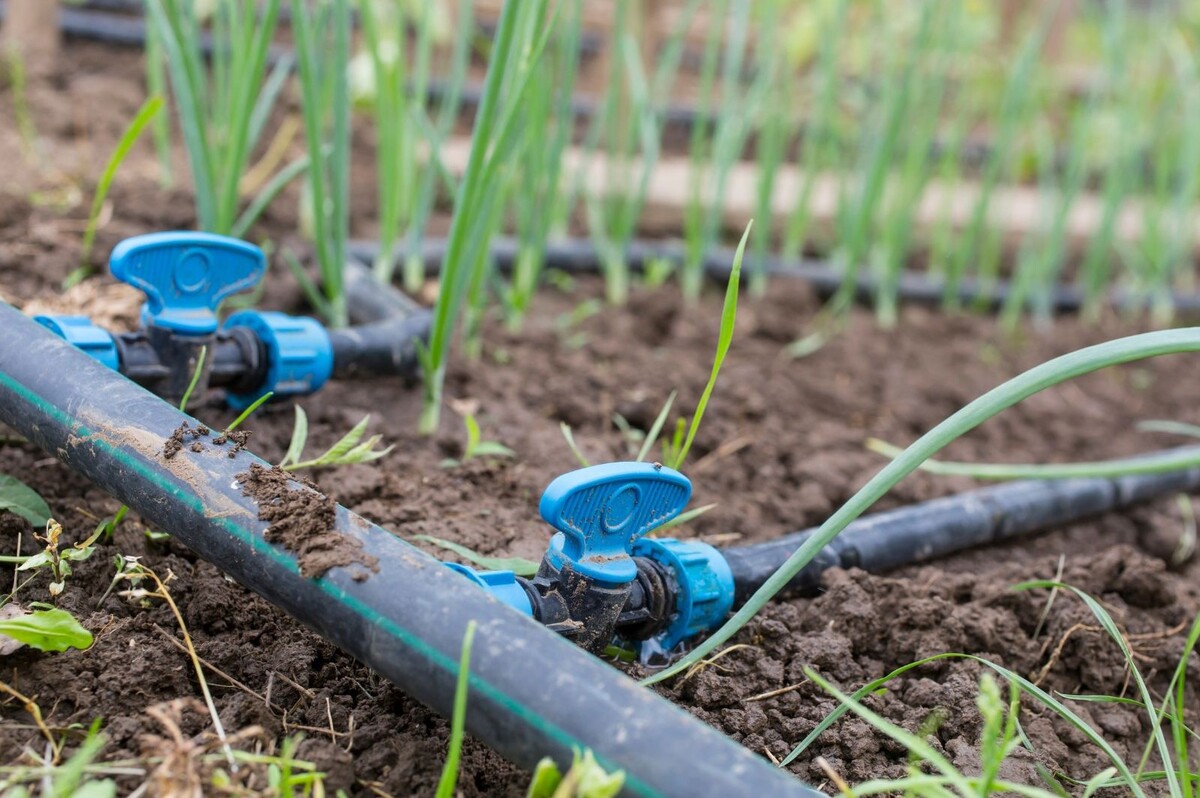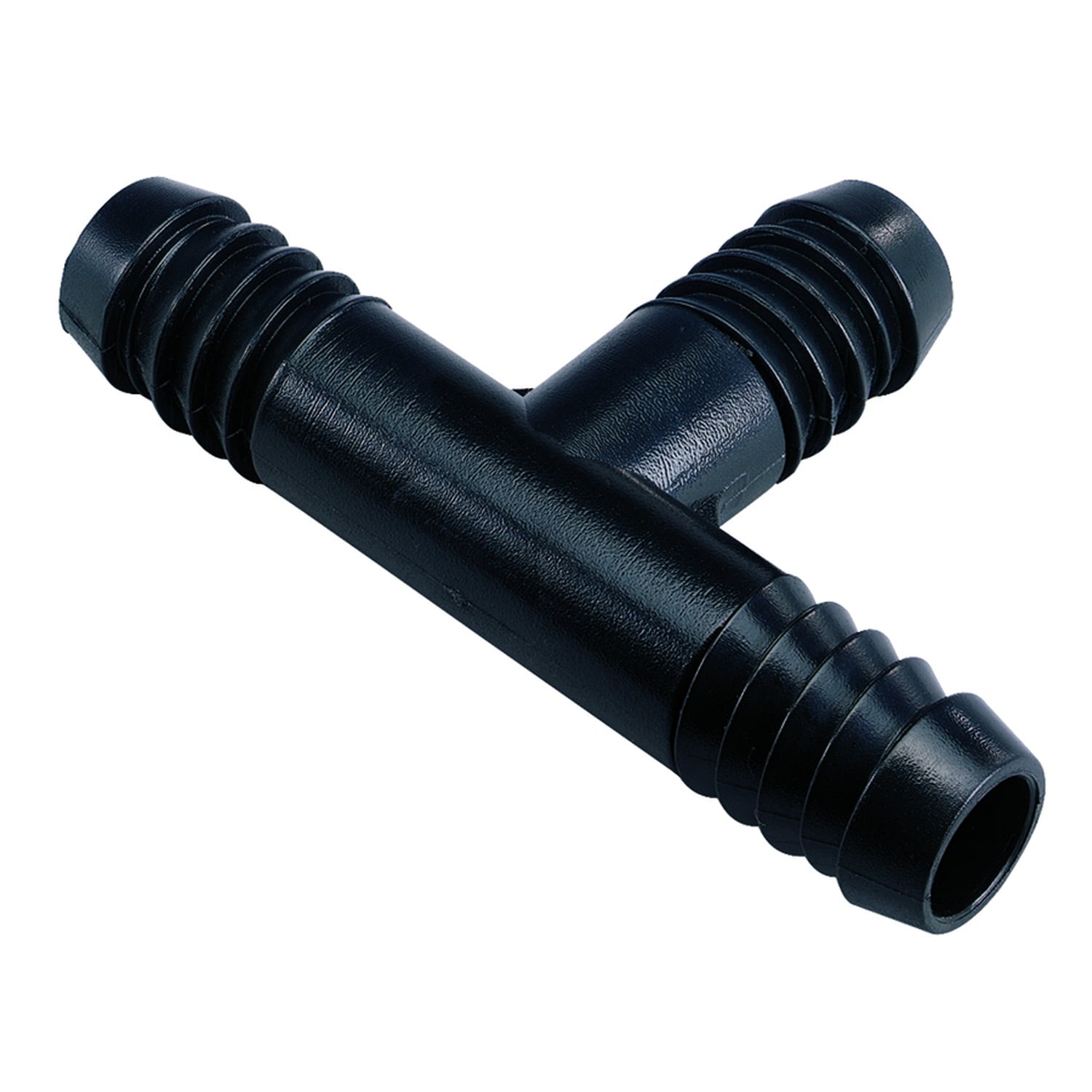Home>Gardening News and Trends>Latest News>What Are Drip Irrigation
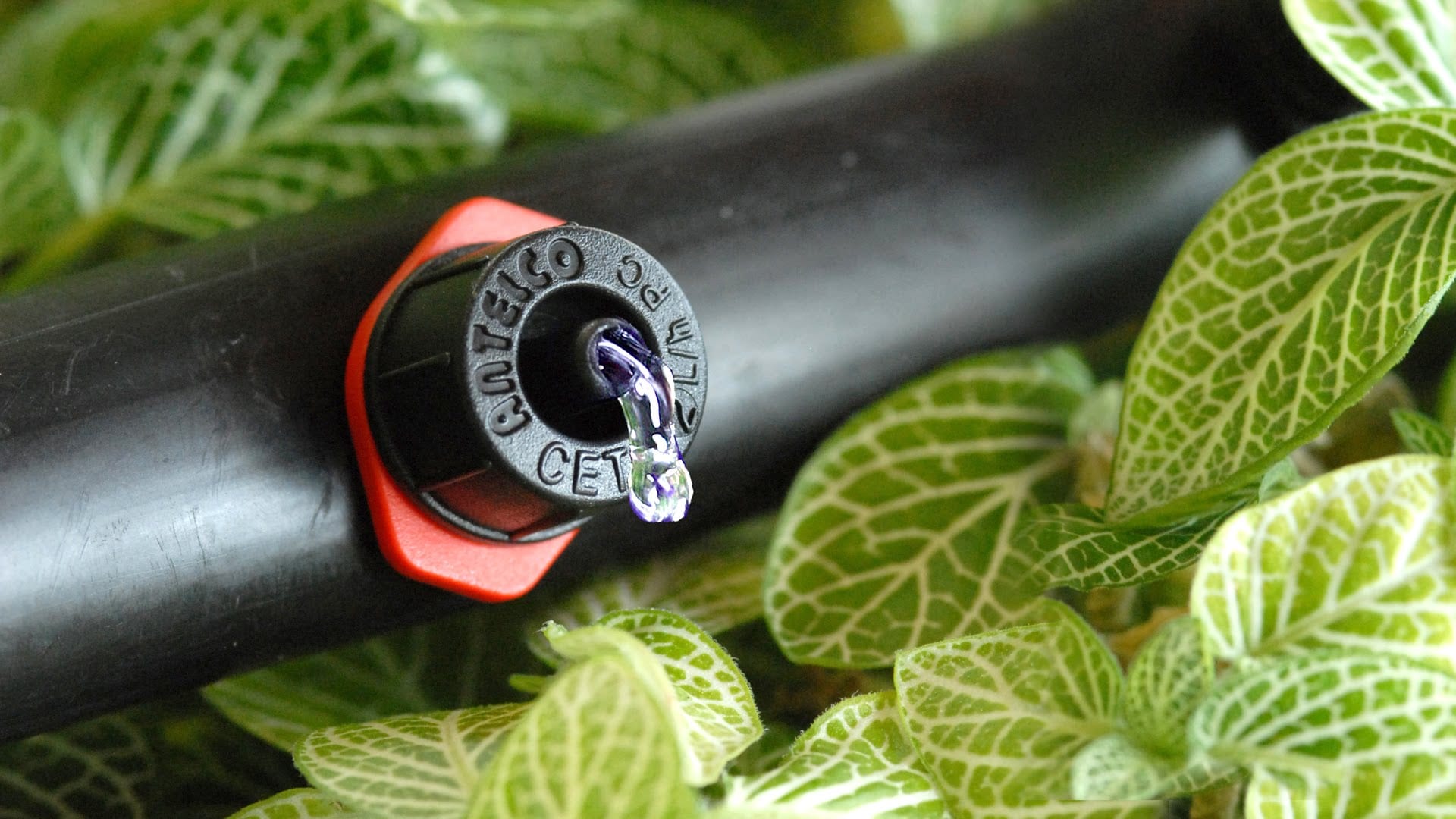

Latest News
What Are Drip Irrigation
Modified: February 8, 2024
Stay updated with the latest news on drip irrigation techniques and advancements. Learn about the benefits and how to implement drip irrigation in your garden or farm.
(Many of the links in this article redirect to a specific reviewed product. Your purchase of these products through affiliate links helps to generate commission for Chicagolandgardening.com, at no extra cost. Learn more)
Table of Contents
- Introduction
- Definition of Drip Irrigation
- Benefits of Drip Irrigation
- Components of Drip Irrigation
- How Drip Irrigation Works
- Types of Drip Irrigation Systems
- Factors to Consider When Installing Drip Irrigation
- Steps to Install Drip Irrigation System
- Maintenance and Troubleshooting of Drip Irrigation Systems
- Conclusion
Introduction
Drip irrigation is a method of irrigation that has gained popularity among farmers, gardeners, and homeowners due to its efficiency and effectiveness in delivering water directly to the roots of plants. It is a system that utilizes small tubes, also known as emitters or drippers, to supply water slowly and steadily to the plants. This method minimizes water waste and reduces the chances of overwatering, making it a sustainable and economical choice for irrigation purposes.
Drip irrigation originated in ancient times, with evidence of its use dating back to the ancient civilizations in China, Egypt, and Mesopotamia. However, it was not until the mid-20th century that drip irrigation systems started to gain widespread recognition and implementation.
The primary objective of drip irrigation is to provide water directly to the root zone of plants, ensuring that they receive the necessary moisture for growth and development. Unlike traditional irrigation methods, such as sprinklers or flood irrigation, drip irrigation minimizes water loss due to evaporation or surface runoff.
In recent years, with the increasing concerns over water scarcity and the need for sustainable agricultural practices, the use of drip irrigation has become even more prominent. It allows for precise water distribution, reducing water usage by up to 50% compared to conventional methods. This not only conserves water but also helps to conserve energy and reduce overall water costs.
Furthermore, drip irrigation offers numerous benefits beyond water conservation. It promotes healthier plant growth by preventing leaf diseases and minimizing weed growth, as the water is delivered directly to the root zone, keeping the leaves dry. Additionally, it reduces the risk of soil erosion, since water is applied in a controlled manner, and minimizes nutrient leaching, as the water infiltrates the soil slowly and steadily.
Overall, drip irrigation is a highly efficient and sustainable method of irrigation that has revolutionized the way we water plants. Its ability to conserve water, promote healthier plant growth, and reduce water and energy costs has made it an attractive choice for farmers, gardeners, and homeowners alike. In the following sections, we will explore the components, types, installation process, and maintenance of drip irrigation systems in more detail.
Definition of Drip Irrigation
Drip irrigation, also known as micro-irrigation or trickle irrigation, is a method of irrigation that delivers water directly to the roots of plants in a slow and controlled manner. Unlike traditional irrigation systems that distribute water over a large area, drip irrigation targets each plant individually with a network of small tubes and emitters.
The key component of drip irrigation is the emitter or dripper, which allows water to drip out slowly and steadily. These emitters are strategically placed near the plants, delivering water directly to the root zone, where it is most needed. By providing water directly to the roots, drip irrigation maximizes the efficiency of water usage, minimizing evaporation and runoff.
In a drip irrigation system, the water supply is usually connected to a main water line using a pressure regulator, a filter, and a backflow prevention device. The main water line is then divided into smaller lateral lines, which are connected to individual plants using drip tubing or drip tape.
Drip irrigation systems can be designed in various configurations to suit different types of landscapes and crops. For example, in agricultural settings, drip irrigation may consist of long lines of tubing with evenly spaced emitters installed along rows of plants. In home gardens or landscapes, it may involve a combination of emitters, micro-sprayers, and soaker hoses to meet the specific watering needs of different plants.
One of the defining features of drip irrigation is its flexibility and adaptability. It allows for precise control over the amount of water delivered to each plant, which is especially beneficial for areas with uneven terrain or varying soil types. This targeted approach to irrigation ensures that moisture is distributed evenly, promoting healthy plant growth and reducing the risk of water wastage.
Drip irrigation is suitable for a wide range of applications, from small garden beds to large agricultural fields. It can be used for growing vegetables, fruit trees, flowers, and even potted plants. The versatility and efficiency of drip irrigation make it a popular choice for water-savvy gardeners, farmers, and landscapers.
In the following sections, we will explore the various components of drip irrigation and how they work together to create an efficient and effective irrigation system.
Benefits of Drip Irrigation
Drip irrigation offers a multitude of benefits, making it a preferred irrigation method for farmers, gardeners, and homeowners. Let’s explore some of the key advantages of using drip irrigation.
1. Water Conservation: Drip irrigation is renowned for its water-saving capabilities. By delivering water directly to the root zone of plants, it minimizes evaporation and runoff, resulting in significant water savings. Compared to conventional irrigation systems, such as sprinklers or flood irrigation, drip irrigation reduces water usage by up to 50%.
2. Enhanced Plant Health: With drip irrigation, water is delivered precisely to the roots of plants, promoting healthier growth. By keeping the leaves dry, it reduces the risk of fungal diseases and leaf damage. Additionally, drip irrigation prevents overwatering and underwatering, ensuring that plants receive the right amount of moisture for optimal growth and development.
3. Weed Control: Drip irrigation focuses water delivery to the desired plant area, reducing water exposure to surrounding weeds. Since weed growth depends on water availability, drip irrigation minimizes weed growth, saving time and effort spent on weed control.
4. Nutrient Efficiency: Drip irrigation allows for precise control over the application of fertilizers and nutrients. By delivering water directly to the root zone, it ensures that nutrients are efficiently absorbed by the plants, reducing nutrient leaching and waste.
5. Soil Erosion Prevention: The slow and controlled water application of drip irrigation helps prevent soil erosion. Unlike traditional irrigation methods that can cause surface runoff, drip irrigation infiltrates water into the soil gradually, minimizing erosion risks and preserving soil structure.
6. Energy and Cost Savings: Due to its efficient water distribution, drip irrigation can significantly reduce energy usage and overall water costs. With lower energy requirements for water pumping and reduced water consumption, drip irrigation helps save money while promoting sustainable water management.
7. Increased Crop Yield: Drip irrigation promotes optimal plant growth and improved crop yield. By consistently providing moisture to the root zone, it creates favorable conditions for plants to develop strong root systems and bear abundant fruits or flowers.
8. Versatility and Adaptability: Drip irrigation systems can be customized to suit various landscapes, crop types, and irrigation needs. From small gardens to large-scale agricultural fields, drip irrigation can be tailored to specific requirements, providing flexibility and adaptability.
Whether you have a small backyard garden or a large farming operation, drip irrigation offers a range of benefits that contribute to sustainable water usage, improved plant health, and cost-effective irrigation practices. In the next sections, we will delve into the components and functioning of drip irrigation systems, guiding you through the installation and maintenance processes.
Components of Drip Irrigation
Drip irrigation systems consist of several key components that work together to deliver water efficiently to plants. Understanding these components is crucial for successful installation and operation of a drip irrigation system. Let’s take a closer look at the main components:
1. Main Water Source: The main water source is connected to the drip irrigation system and supplies water to the entire system. It can be a water tap, well, or reservoir, depending on the water source available.
2. Filtration System: To prevent clogging of emitters and ensure smooth operation of the system, a filtration system is essential. This typically includes a filter unit that traps dirt, debris, and particles present in the water, preventing them from entering the drip lines and emitters.
3. Pressure Regulator: Drip irrigation systems require a consistent and regulated water pressure to ensure proper functioning. A pressure regulator is installed to maintain a stable pressure within the system, preventing damage to the emitters and ensuring uniform water distribution.
4. Backflow Preventer: A backflow preventer is an important safety feature that prevents contaminated water from flowing back into the main water supply. It protects drinking water sources from cross-contamination.
5. Distribution Network: The distribution network consists of pipes, tubes, and fittings that carry water from the main water source to the plants. This network includes mainline pipes, lateral lines, and sub-main lines, which connect the water source to individual plant areas.
6. Emitters or Drippers: The emitters, also known as drippers, are the heart of the drip irrigation system. These small devices regulate the flow of water and deliver it directly to the plants. Emitters come in various types, including pressure-compensating, non-pressure-compensating, and adjustable flow emitters, which allow for precise control over water delivery.
7. Microtubing or Drip Tape: Microtubing or drip tape is used to connect the emitters to the mainline or sub-main line. It is a flexible, narrow tube through which water flows from the main line to the plants. Drip tape is a type of flat tubing with built-in emitters, popular for larger-scale agricultural applications.
8. Fittings and Connectors: Fittings and connectors are essential for joining and securing the various components of the drip irrigation system. These include elbows, tees, connectors, and end caps, which ensure a tight and leak-free system.
9. Timer or Controller: A timer or controller can be used to automate the irrigation process. It allows you to set specific watering schedules, ensuring consistent and efficient water delivery to the plants. Some advanced controllers also have sensors that adjust watering based on weather conditions or soil moisture levels.
Understanding the different components of a drip irrigation system is necessary for proper installation, operation, and maintenance. Each component plays a vital role in delivering water efficiently to plants, supporting healthy and productive growth. In the following sections, we will explore how drip irrigation systems work and the different types available for various applications.
How Drip Irrigation Works
Drip irrigation works on the principle of delivering water directly to the roots of plants in a slow and controlled manner. This method ensures efficient water usage and minimizes water loss through evaporation and runoff. Let’s take a closer look at how drip irrigation works:
1. Water Source: A drip irrigation system starts with a water source, which can be a tap, well, or reservoir. The water source provides the necessary water supply for the system.
2. Filtration: Before reaching the plants, the water passes through a filtration system. This system removes dirt, debris, and other particles that can clog the emitters. Filtration ensures a smooth flow of water through the system, preventing blockages and maintaining optimal performance.
3. Pressure Regulation: Next, the water passes through a pressure regulator that maintains a consistent water pressure within the system. This is important to ensure that the emitters operate at their designated flow rates and deliver water uniformly to the plants.
4. Distribution Network: The water is then distributed through a network of pipes, tubes, and fittings. The distribution network consists of mainline pipes, lateral lines, and sub-main lines. These lines carry water from the water source to the individual plants or rows of plants.
5. Emitters: Emitters, also known as drippers, are installed at strategic locations along the distribution lines. These small devices regulate the flow of water and deliver it directly to the plants. Each emitter has a specific flow rate, allowing precise control over the amount of water delivered to each plant.
6. Microtubing or Drip Tape: Microtubing or drip tape connects the emitters to the main distribution lines. This narrow tubing carries water from the distribution lines to the base of each plant or directly to the root zone. The microtubing or drip tape is flexible and can be easily maneuvered around plants or in rows.
7. Watering Schedule: A timer or controller can be used to automate the watering schedule. The controller allows users to set specific watering times and durations, ensuring that the plants receive sufficient water without overwatering. Some advanced controllers can even adjust the watering schedule based on weather conditions or soil moisture levels.
8. Plant-Based Watering: In drip irrigation, water is delivered directly to the roots of plants. This targeted approach ensures that plants receive water where they need it the most, promoting healthier growth and reducing the risk of water wasting.
By delivering water directly to the root zone, drip irrigation minimizes evaporation and surface runoff. It allows plants to efficiently absorb water, enhances nutrient uptake, reduces weed growth, and prevents water-related diseases. Overall, drip irrigation provides a precise and efficient method of watering plants, saving water and promoting sustainable irrigation practices.
In the next section, we will explore the different types of drip irrigation systems available and their applications.
Types of Drip Irrigation Systems
Drip irrigation systems come in various types, each designed to suit different applications and irrigation needs. Understanding the different types of drip irrigation systems can help you choose the most appropriate system for your specific requirements. Here are some common types of drip irrigation systems:
1. Surface Drip Irrigation: Surface drip irrigation is the most commonly used type of drip irrigation system. In this system, drip emitters are placed on or slightly above the soil surface, near the base of each plant. Water is directly delivered to the soil, allowing the roots to absorb the water efficiently. This type of system is versatile and suitable for a wide range of crops, including vegetables, fruits, and ornamental plants.
2. Subsurface Drip Irrigation (SDI): Subsurface drip irrigation involves burying the drip lines or tape beneath the soil surface. The emitters release water below the soil, directly into the root zone of the plants. This method minimizes water evaporation and reduces weed growth. SDI is commonly used for crops like row crops, orchards, and vineyards, where water efficiency is essential.
3. Container Drip Irrigation: As the name suggests, container drip irrigation is designed for potted plants or container gardens. In this system, individual pots or containers are connected to a drip irrigation system using microtubing or drip emitters. This allows for precise watering of each container, ensuring that plants receive the right amount of water.
4. Hanging Basket Drip Irrigation: Hanging baskets often require specialized irrigation due to their unique design. Hanging basket drip irrigation systems consist of small tubing or emitters that deliver water directly to the hanging baskets, preventing water runoff and ensuring optimal hydration for the plants.
5. Greenhouse Drip Irrigation: Greenhouse drip irrigation systems are specially designed for greenhouse environments. They involve the use of drip lines or emitters placed on or below the soil surface, delivering water directly to the roots of plants. This method ensures efficient water usage and helps maintain optimal moisture levels in the controlled environment of the greenhouse.
6. Garden Drip Irrigation: Garden drip irrigation systems are designed for small-scale gardens and home landscapes. They typically involve a combination of drip emitters, micro-sprayers, and soaker hoses to cater to different watering needs. Garden drip irrigation systems can be customized based on the layout and size of the garden, delivering water precisely to plants and minimizing water waste.
The choice of drip irrigation system depends on factors such as the type of crop or plants being irrigated, the layout of the area, and the specific irrigation requirements. It’s important to consider these factors to determine the most suitable drip irrigation system for your needs.
In the following sections, we will explore factors to consider when installing a drip irrigation system, as well as the step-by-step process for installation and maintenance.
Factors to Consider When Installing Drip Irrigation
When planning to install a drip irrigation system, it’s important to consider several factors to ensure its effectiveness and efficiency. Taking these factors into account will help determine the appropriate design and configuration for your specific irrigation needs. Here are some key factors to consider:
1. Water Source and Supply: Assess the availability and reliability of the water source for your drip irrigation system. Consider factors such as water pressure, flow rate, and the capacity of the water source to meet the demands of your irrigation system. Adequate water supply is essential for the proper functioning of the system.
2. Soil and Plants: Understand the soil type, drainage, and moisture retention characteristics of your garden or farming area. Different soil types will require specific irrigation practices. Additionally, consider the water requirements of the plants you are intending to irrigate. Some plants may require more frequent or deeper watering than others.
3. Climate and Weather Conditions: Take into account the local climate and weather conditions when designing your drip irrigation system. Factors such as temperature, humidity, wind, and rainfall patterns will influence the watering needs of your plants. Consider whether there are any seasonal variations that may affect irrigation requirements.
4. System Design and Layout: Design the layout of your drip irrigation system based on the specific area you wish to irrigate. Consider the shape, size, and topography of the area, as well as any obstacles such as trees, structures, or pathways. Proper system design ensures that water is distributed evenly and reaches all the desired plants.
5. Plant Spacing and Watering Zones: Determine the spacing between plants and group them according to their water requirements. This will allow for efficient water distribution and prevent overwatering or underwatering. Different plants may require different flow rates or watering durations, so dividing your irrigation system into distinct watering zones can optimize water usage.
6. Drainage and Runoff: Evaluate the drainage capacity of your soil to avoid waterlogged conditions. Proper drainage is essential to prevent the accumulation of excess water around the roots, which can lead to root rot or other water-related issues. Adjust the irrigation schedule and frequency accordingly based on the soil’s drainage capacity.
7. Maintenance and Accessibility: Consider the accessibility of the components of the drip irrigation system for maintenance and repairs. Installing valves or shut-off points at strategic locations will allow for easier maintenance and repair work. Ensure that filters and emitters are easily accessible for cleaning and replacement.
8. Budget and Resources: Determine your budget and available resources for installing and maintaining the drip irrigation system. Consider the cost of materials, tools, and equipment, as well as ongoing maintenance requirements. Balancing your budget with the long-term benefits of water savings and plant health will help you make informed decisions.
By considering these factors during the planning phase, you can design and implement a drip irrigation system that is tailored to your specific needs. This will maximize water efficiency, prevent plant stress, and promote healthy growth. In the next section, we will walk through the step-by-step process of installing a drip irrigation system.
Steps to Install Drip Irrigation System
Installing a drip irrigation system requires careful planning and attention to detail to ensure its proper functioning. Here are the essential steps to follow when installing a drip irrigation system:
1. Plan and Design: Begin by assessing the area you want to irrigate and create a detailed plan. Consider factors such as plant locations, water source, water pressure, and the layout of the area. Incorporate this information into your design, including the placement of emitters, tubing, and mainlines.
2. Gather Materials and Tools: Once your design is finalized, gather all the necessary materials and tools for the installation. This may include drip tubing or tape, emitters, connectors, fittings, pressure regulators, filters, timers or controllers, and any additional accessories required.
3. Prepare the Area: Before installing the system, prepare the area by clearing away debris, weeds, and any obstructions that may interfere with the irrigation lines. Level the ground if needed to ensure even water distribution.
4. Lay the Mainline: Start by laying the mainline from the water source to the designated irrigation area. Use trenching tools or a shovel to create a trench for the mainline. Place the mainline securely in the trench, making sure it follows the desired route.
5. Connect the Components: Install the fittings, connectors, and other components based on your design plan. Connect the mainline to the water source, ensuring a tight and secure connection. Install the pressure regulator and filtration system as needed.
6. Lay the Lateral Lines: Lay the lateral lines from the mainline to each plant or row of plants. Connect the lateral lines to the proper fittings or connectors on the mainline. Use stakes or clips to secure the tubing in place and prevent movement.
7. Install Emitters: Install the emitters or drippers at the base of each plant or directly onto the lateral lines. Ensure that the emitters are properly secured and aligned with the plants’ root zones.
8. Install the Timer or Controller: If desired, install a timer or controller to automate the watering schedule. Follow the manufacturer’s instructions for proper installation and programming.
9. Test and Adjust: Once the installation is complete, turn on the water supply and test the system. Check for any leaks, uneven water distribution, or other issues. Adjust the flow rates or positions of emitters as needed to ensure proper coverage.
10. Mulch and Insulate: Apply a layer of mulch around the plants to help retain moisture and regulate soil temperature. Insulate any exposed tubing or emitters to protect them from damage or extreme weather conditions.
11. Regular Maintenance: Regularly inspect the system for any leaks, clogs, or damaged components. Clean or replace filters as needed. Adjust the watering schedule based on plant needs, weather conditions, and seasonal changes.
By following these steps and maintaining the drip irrigation system properly, you can ensure efficient water usage, healthy plant growth, and long-term success with your irrigation system.
Maintenance and Troubleshooting of Drip Irrigation Systems
Proper maintenance of a drip irrigation system is crucial to keep it functioning efficiently and ensure optimal plant growth. Regular upkeep and troubleshooting can help identify and address issues before they cause significant damage. Here are some maintenance tasks and troubleshooting tips for drip irrigation systems:
1. Regular Inspections: Regularly inspect the entire system, including the mainline, lateral lines, emitters, and filters. Look for leaks, clogs, or damaged components. Check for any signs of wear and tear, such as cracked tubing or loose fittings. Address any issues promptly to prevent water loss and inefficient irrigation.
2. Clean Filters: Clean or replace filters regularly to prevent clogging and maintain proper water flow. Remove debris, sediments, and mineral deposits that accumulate in the filters to ensure clean water reaches the emitters. Follow the manufacturer’s instructions for proper cleaning techniques.
3. Check Emitters: Examine each emitter or dripper to ensure it is delivering water correctly and evenly. Clean or replace any clogged emitters that are not releasing water properly. Adjust the flow rates of the emitters, if necessary, to match the water requirements of each plant.
4. Monitor Water Pressure: Regularly check the water pressure within the system using a pressure gauge or a pressure monitoring device. Ensure that the pressure regulators are functioning correctly and maintaining the desired pressure range. Adjust the pressure as needed to optimize water distribution.
5. Mulch and Insulate: Apply mulch around the plants to help minimize evaporation, regulate soil temperature, and reduce weed growth. Insulate exposed tubing or emitters to protect them from extreme temperatures or physical damage.
6. Adjust Timer or Controller: Regularly review and adjust the watering schedule on the timer or controller based on plant needs, weather conditions, and seasonal changes. Consider factors such as rainfall, temperature, and plant growth to ensure sufficient but not excessive watering.
7. Winterize the System: Before freezing temperatures occur, properly winterize the drip irrigation system to prevent damage to the components. This may involve draining the water from the system, insulating exposed pipes, and protecting emitters and tubing from freezing conditions.
8. Troubleshooting Common Issues: Address common issues such as leaks, uneven water distribution, or low water pressure promptly. Check for any blockages in the tubing or emitters and clear them if necessary. Adjust the flow rates or positioning of emitters to ensure uniform coverage.
9. Seek Professional Help: If you encounter complex issues or are unsure how to address a problem, it’s recommended to seek assistance from a professional or contact the manufacturer for guidance.
Regular maintenance and troubleshooting will help ensure a properly functioning drip irrigation system, saving water, and promoting healthy plant growth. It is important to address any issues promptly to prevent further damage and optimize the system’s performance. By staying vigilant and proactive, you can enjoy the benefits of a well-maintained drip irrigation system for years to come.
Conclusion
Drip irrigation is a highly efficient and sustainable method of watering plants, offering numerous benefits for farmers, gardeners, and homeowners. By delivering water directly to the roots of plants in a controlled manner, drip irrigation minimizes water waste, promotes healthier plant growth, and reduces water and energy costs.
Throughout this article, we have explored the various aspects of drip irrigation, including its definition, benefits, components, functioning, types, installation, and maintenance. Drip irrigation provides precise and targeted watering, reducing the risk of overwatering or underwatering and ensuring that plants receive the right amount of moisture for optimal growth and development.
With its ability to conserve water, enhance plant health, control weed growth, prevent soil erosion, and save on energy and costs, drip irrigation is a standout choice for sustainable irrigation practices. It can be customized to suit different landscapes, crop types, and irrigation needs, making it versatile and adaptable.
Aspiring drip irrigation system installers should consider factors such as water source, soil and plants, climate, system design, and budget when planning for installation. Following the step-by-step installation process and conducting regular maintenance tasks can help ensure the system’s proper functioning and longevity.
Remember to inspect the system regularly, clean filters, check emitters, monitor water pressure, adjust the timer or controller when needed, and troubleshoot common issues promptly. By doing so, you can maximize water efficiency, prevent water-related diseases, and optimize the overall performance of your drip irrigation system.
In a world where water scarcity and environmental sustainability are critical issues, adopting efficient irrigation practices like drip irrigation is crucial. By using water wisely and minimizing water waste, we can contribute to a more sustainable future while enjoying the benefits of lush and healthy plants.
So, whether you’re a farmer looking to irrigate crops, a gardener wanting to beautify your landscape, or a homeowner seeking a more effective watering method for your backyard garden, drip irrigation is a reliable and efficient choice. Embrace the benefits of drip irrigation and experience the wonders it can bring to your plants and water conservation efforts.
